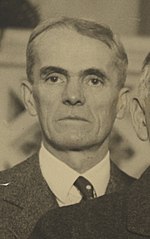Walter Sydney Adams
Walter Sydney Adams | |
|---|---|
 Walter Sydney Adams | |
| Born | December 20, 1876 |
| Died | May 11, 1956 (aged 79) |
| Nationality | American |
| Alma mater | Dartmouth College University of Chicago |
| Awards |
|
| Scientific career | |
| Fields | Astronomy |
| Institutions | Mount Wilson Observatory Yerkes Observatory |
Walter Sydney Adams (December 20, 1876 – May 11, 1956) was an American astronomer.[1][2][3][4][5][6] He is renowned for his pioneering work in spectroscopy.[7]
Life and work
[edit]Adams was born in Antioch, Ottoman Empire, to Lucien Harper Adams and Nancy Dorrance Francis Adams, missionary parents,[8] and was brought to the U.S. in 1885[1] He graduated from Dartmouth College in 1898, then continued his education in Chicago and in Germany. After returning to the U.S., he began a career in Astronomy that culminated when he became director of the Mount Wilson Observatory.
His primary interest was the study of stellar spectra. He worked on solar spectroscopy and co-discovered a relationship between the relative intensities of certain spectral lines and the absolute magnitude of a star. He was able to demonstrate that spectra could be used to determine whether a star was a giant or a dwarf. In 1915 he began a study of the companion of Sirius and found that despite a size only slightly larger than the Earth, the surface of the star was brighter per unit area than the Sun and it was about as massive.[9] Such a star later came to be known as a white dwarf. In 1925, he reported a gravitational redshift caused by Sirius B; this was regarded as significant confirmation of Albert Einstein's theory of General Relativity. It is now known that his reported measurements were incorrect. Along with Theodore Dunham, he discovered the strong presence of carbon dioxide in the infrared spectrum of Venus.
Adams died at the age of 79 in Pasadena, California.

Awards and honors
[edit]Awards and honors
- Member of the American Philosophical Society (1915)[10]
- Gold Medal of the Royal Astronomical Society (1917)[11]
- Member of the United States National Academy of Sciences (1917)[12]
- Henry Draper Medal from the National Academy of Sciences (1918)[13]
- Fellow of the American Academy of Arts and Sciences (1922)[14]
- Valz Prize from the French Academy of Sciences (1923)[15]
- Prix Jules Janssen, the highest award of the Société astronomique de France, the French astronomical society (1926)
- Bruce Medal (1928)[16][17]
- Janssen Medal from the French Academy of Sciences (1934)
- Foreign Member of the Royal Society (ForMemRS) (1950)[1]
- Henry Norris Russell Lectureship (1947)
Named after him
- The asteroid 3145 Walter Adams.
- The crater Adams, a crater on Mars.[18]
- The crater Adams on the Moon is jointly named after him, John Couch Adams and Charles Hitchcock Adams.
References
[edit]- ^ a b c d Stratton, F. J. M. (1956). "Walter Sydney Adams 1876-1956". Biographical Memoirs of Fellows of the Royal Society. 2: 1–25. doi:10.1098/rsbm.1956.0001. JSTOR 769472. S2CID 129593096.
- ^ Walter Sydney Adams — Biographical Memoirs of the National Academy of Sciences
- ^ MNRAS 117 (1957) 243
- ^ Obs 76 (1956) 139
- ^ PASP 68 (1956) 285
- ^ Wright, Helen (1970). "Adams, Walter Sydney". Dictionary of Scientific Biography. Vol. 1. New York: Charles Scribner's Sons. pp. 54–58. ISBN 0-684-10114-9.
- ^ "Walter Adams | American astronomer | Britannica". www.britannica.com. Retrieved 2023-05-02.
- ^ "Walter Sydney Adams Papers". www.amphilsoc.org. Archived from the original on 2015-05-01.
- ^ F. Wesemael, A comment on Adams's measurement of the gravitational redshift of Sirius B Royal Astronomical Society, Quarterly Journal (ISSN 0035-8738), 26, Sept. 1985, 273-278
- ^ "APS Member History". search.amphilsoc.org. Retrieved 2023-10-31.
- ^ Awarding of RAS gold medal
- ^ "Walter Adams". www.nasonline.org. Retrieved 2023-10-31.
- ^ "Henry Draper Medal". National Academy of Sciences. Retrieved 19 February 2011.
- ^ "Book of Members, 1780-2010: Chapter A" (PDF). American Academy of Arts and Sciences. Retrieved 6 April 2011.
- ^ "Prix Benjamin Valz". Comptes Rendus Hebdomadaires des Séances de l'Académie des Sciences. 177: 1366. December 17, 1923.
- ^ Bruce Medal page
- ^ Awarding of Bruce Medal
- ^ "Honorary Member: Walter Sydney Adams". Royal Astronomical Society of Canada. 11 May 2012. Retrieved 2017-11-06.
Further reading
[edit]- Asimov's Biographical Encyclopedia of Science and Technology, Isaac Asimov, Doubleday & Co., Inc., 1972, ISBN 0-385-17771-2.
- 1876 births
- 1956 deaths
- 20th-century American astronomers
- Dartmouth College alumni
- Foreign members of the Royal Society
- People from Antioch
- Recipients of the Gold Medal of the Royal Astronomical Society
- Members of the United States National Academy of Sciences
- Fellows of the American Academy of Arts and Sciences
- American expatriates in the Ottoman Empire
- Members of the American Philosophical Society
